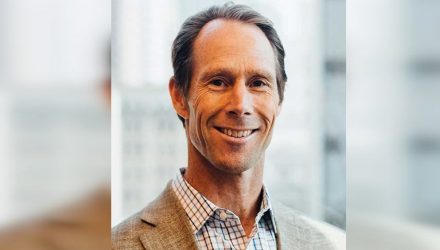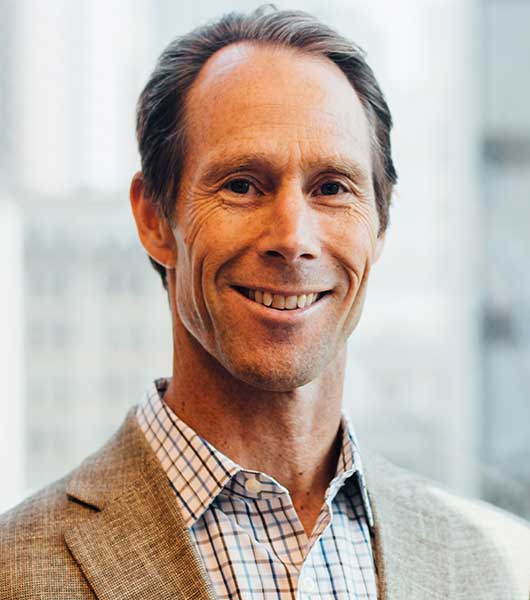Evan Harp sat down with Main Management’s founding partner Kim Arthur at Exchange for a wide-ranging discussion about the markets, China, the U.S. dollar, taxes, and more.
Evan Harp: How do you feel about Exchange, what’s stuck out to you?
Kim Arthur: The sponsors are doing an awesome job, and VettaFi has done a great job here. I think the layout is — I know it’s the same venue — but it feels even better than last year with all the cabanas that are outside. They really built that up versus last year. There are all these areas to have great exchange, you’ve got education, and then you get the community of people that you get to talk to more.
Evan Harp: Really glad to hear that! I would love to hear more about your firm, Main Management, and what sets you apart. I’m also interested in getting the Main Management “house take” on the markets right now in early 2023.
Kim Arthur: Main Management is based in San Francisco, we are a partner-owned firm. 15% of the assets that we have are our partners’ money, which we think is extremely important. That means we’re completely aligned with our clients, we’re invested right alongside them. And we’ve been doing this for 20 years.
When we started 20 years ago, we were one of the early firms that was exclusively using exchange traded funds to build strategies with active risk management. It was pretty unusual back then. Now there are lots of strategists and money managers who do that same thing. There were only 100 ETFs when we started, now there are thousands! In our lifecycle, we’ve watched that growth explode. I think that is one thing that sets us apart.
The other thing, and I know a lot of people say this, but we really execute on it: We are client-focused with exceptional service. Lots of firms can say that, but there are very few that are actually executing on that. It’s part of our culture.
I’m very, very, very committed that all the team members that join us realize that those are the two hallmarks of our firm.
Evan Harp: I love that answer, and before we pivot to your market outlook, I actually have a question off of that. What is the thing that separates good service from exceptional client service?
Kim Arthur: That’s a great question. I personally think it is where you’ve got to realize you are a fiduciary, you’re always putting your client’s interest in front of you. So, I think, if you do that from the beginning, and you realize that it’s the client that is actually driving your business and that they’re the ones that are keeping you alive… I think when you have both of those together, it’s very natural for us to give them exceptional service.
I feel that by having that fiduciary outlook and then realizing that we wouldn’t be in business without the clients, we better give 100-plus percent every single day.
Evan Harp: Great answer. I’m wondering if you could now give me your market view? To set some table stakes, we were coming off of 2022, which was a weird year, quite unlike any in recent memory, and people don’t know what to make of 2023 yet. You could walk into a room with 10 different economists, and five of them will probably say we’re going to have a recession, while the other five of them will say things are fine and a soft landing for the Fed is on the table. What do you make of it?
Kim Arthur: First, let’s look back on 2022 — the market became almost exclusively focused on how high rates would go. Going into 2022, people thought that they were going to raise rates by less than one basis point. Everyone thought the market was going to come in higher a year ago. It started the year at 4800; they all thought it would be 5000 by the end of the year.
Juxtapose that to the year that we got — which you just mentioned was down -18%. That caught everybody off guard, and peak-to-trough, it was actually down to -27%.
Evan Harp: Wow.
Kim Arthur: And it pounded on people. What happened is you’ve got the polar opposite for 2023. Coming into the year, everyone said, “Oh my gosh, we’re going to retest and break to new lows here in the first quarter.” I’ve never seen a more predicted recession than what people wanted for this year.
Because we’re a little bit of contrarians, we came in thinking that consensus is rarely right. Sometimes it is. But sometimes, it’s good to lean against it. We actually felt that the lows had happened in October when rates peaked and that given the strength of the economy and the reflation coming down, that this was going to be more of a transition year, not a train wreck year — you had the train wreck last year.
So I think you’re already seeing it here last week when you had non-farm payrolls that were 500,000+. You don’t have a recession when unemployment is at 3.4%.
You’re also getting to a place where real incomes are positive. So, people are earning more on an after-inflation basis than the inflation rate. That usually means it gives them more spending money to go out with. We’re actually fairly constructive, knowing that you’re going to have some speed bumps that you’re going to hit here, but I think it’s going to be a lot of bad news was discounted, and in the market, price and proof rarely happens at the same time.
Evan Harp: That makes a lot of sense. It actually inspires another question: You have positioned your firm as contrarians. It’s a great time to be a contrarian in a lot of ways, there’s a lot of opportunity available in covering ground that other people aren’t covering. So, what is the one thing that you feel like people aren’t paying attention to in the markets but that they should be paying attention to?
Kim Arthur: I think the U.S. dollar just got done with a 12-year bull market. It’s not unusual to have these long, dated bull markets in the dollar. The one previous, that was seven years, from 1995 to 2002.
We think the dollar topped at the end of September. Now, there’ll be countertrend rallies that happen, but the significance and importance of that is that international equities have been an awful asset class for 12 years.
Evan Harp: What a coincidence!
Kim Arthur: [Laughs] Right! What a coincidence! That is the most highly correlated predictive indicator for how international assets will do. It’s like if the dollar is going up, you aren’t going to make any money in those international assets. When the dollar has topped and it’s going down, you can beat the S&P. The last time, that 2002 to 2007 period, you almost beat the S&P with international equities by two to one.
The other thing is, if you mention the “I”-word, “international,” the clients, they’re running! It’s a four-letter word. So, I think that people are underexposed. The dollar coming down coupled with cheap, absolute, and relative valuations equals opportunity.
Evan Harp: That’s really smart. I like that take a lot. So I want to drill into that a little bit more and see if we can get specific about some emerging and even frontier markets as well. What do you think is going to happen with China, given the recent tensions between the U.S. and China, as well as China’s own economic recovery? What do you make of the state of emerging markets? And as a third bonus question, where do frontier markets sit in all of this?
Kim Arthur: It’s interesting. Let’s take emerging markets and look at China specifically. One of the big plays in China is China tech.
At the previous height, you had the Nasdaq and China tech that both traded at similar price to sales. So they were both on parity, which it probably shouldn’t have been for China, given the political risks there. That was probably a little over its skis.
It then got down to an October period where it was trading at about a 66% discount to it. That was probably too big of a discount. It’s now floated back up to where it’s at a 40% discount, which is probably about the right discount that you should have.
I think you have to be selective with China. As you mentioned, China’s got a bunch of headwinds here. They’ve got demographics that are going the wrong way. They are becoming the largest nursing home in the world. Japan used to be the largest, but they only have 120 million people — now you got over a billion in China, and they just realized they were overcounting by 100 million people!
When you have that type of situation, you have to rely on productivity and a lot of other things. I think there are pockets of opportunity in China. I think other emerging markets that look interesting too. Brazil, at seven times forward earnings, seems very, very cheap. Poland — I know there’s a war going on next door, and that’s never good for your economy, but they’re trading at seven times forward earnings.
So again, that’s where price and proof rarely happen at the same time, you’re probably getting paid for that.
The frontier markets are a little trickier because most of those frontier markets tend to be very oil-dependent. So you get stuff in the Middle East, or you get a Nigeria, and they’re very oil-dependent. You have to have a very firm outlook on oil and where the price of that commodity is going to go to make a play for it.
The developed markets are interesting in Europe in that everyone was convinced they were going to have a recession last year because of the dependence on oil and Russia. Then it turned out that they actually kind of avoided it. They’re coming out now, they’ve had a very mild winter, which has helped them out. So, I think you have to, as always, got to be selective with your regional picks. Then, within those specific countries, you can try to find opportunity. But if you let valuation be your guidepost and you look at historical valuations, usually you’re able to come up with something that makes sense on a risk/reward basis.
Evan Harp: That makes a ton of sense. Let’s pivot to something else entirely: taxes. Tax season is upon us. What’s your take?
Kim Arthur: I think one of the key advantages with exchange traded funds, and we saw this last year with mutual funds, is that mutual funds — for the first time since 2008 — gave people a loss, and they gave them a capital gains distribution. That’s adding insult to injury. Meanwhile, with the ETF structure, you have the unique quality of custom redeems and creates — you should never have an exchange traded fund that delivers a capital gain. If the manager is running it properly, you should be able to get rid of that. So, I think, from a taxation standpoint, it’s very, very key.
This year, active management in both ETFs and mutual funds is said to have a potential advantage against market cap-weighted and passive investing due to the rising rate environment and increased uncertainty. The current market environment plays to the strength of these active managers, but that ETF structure with the tax advantage is very important. I live in the People’s Republic of California, and the tax rate is extremely, extremely high out there. So again, we’re very much focused on after fees, after tax, what the investor gets to eat.
For more news, information, and analysis, visit the ETF Strategist Channel.


